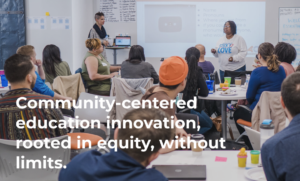Leadership and Design Skills Chart the Future of Work

By Emily Liebtag and Tom Vander Ark.
Taliq Tillman (above) is an outspoken sophomore at an Ivy League college and the co-founder of Diversity Talks, a nonprofit that gives voice to marginalized students. Tillman described to an audience at the University of Pennsylvania how traditional education—including the best known colleges—often marginalizes students of color like him by making faulty assumptions about what they can and can’t do.
Tillman found his voice at the MET High School in Providence, R.I. “Teachers actually listened to me,” Tillman said. “I had four years where I had the same advisor, and I was able to text him whenever I needed him. When I was applying to colleges, he actually came to my home because he understands that students like me just need someone to believe in them, to tell them you are good enough, that despite everything you have been through, you are smart, you are intelligent.”
The MET is the flagship school of the Big Picture network, where teachers craft learning pathways “one kid at a time.” At the MET, Tillman developed his leadership skills participating in several internships and community connected projects.
Tillman was one of 10 youth leaders that facilitated Catalyst Conversations at a #FutureofWork convening hosted by Getting Smart, ISTE and Catalyst@Penn GSE.
Simone (below) is a student at Philadelphia’s Science Leadership Academy (SLA) and was another table captain. People often wonder how SLA students are represented everywhere in the city, with an enrollment of only 500. The student leadership apparent across Philadelphia is “because of what is taught at SLA,” said Chris Lehmann, founding principal of SLA. “We want kids to understand that what we do now matters. Right now. Today.”

Harry and JD (below) came all the way from Boise, Idaho, to share how their training in design thinking at One Stone, an innovative new high school, prepared them to take on community challenges. One Stone aims to empower a youth army of “good for good” and cultivates student voice and leadership.

Working in small groups, the students then described their lives and their schools. Yonas Kemal, a rising senior at a traditional public high school in North Carolina, told his group about District C, a nonprofit that develops leadership and problem-solving skills.
“I’ll have homework to do and an essay to write, but I’ll also have a website to build,” Kemal said. “It’s not all school, but I’m learning so I put it all on the same level. It can be a challenge, but a good challenge.”

These student facilitators had the benefit of high school programs that developed their leadership skills and invited them to solve interesting problems—what Seth Godin frequently cites as the two most important skills for young people to acquire.
For 20 years, we’ve asked high schools to prepare most young people for college by pushing them through a checklist of courses focused on content and procedures.
#FutureofWork conversations like the one at Penn made clear the benefits of schools and programs that help young people figure out who they are, what they are good at, what the world needs, and what they care about—and put them to work making their initial contribution at that intersection.
Schools that value routine and compliance around facts and formulas do not yield the personal agency and leadership skills demanded by a world full of novelty and complexity.
It is encouraging to see a growing number of schools and programs that develop the design thinking and entrepreneurial mindset that young people need to dive into complex problems and make a difference in their community.
To create momentum for more valuable learning experiences in your community, hold a conversation with parents, teachers, students and business leaders. Ask them to reflect on what’s happening, what it means, and how to prepare. Watch this three-minute video of the meeting at Penn to learn more. Then get started thinking about how you might implement change in your own community.
For more, see:
- Developing Skills for School, Work and Life Requires a Systematic Approach
- How to Fix Higher Education: Seven Keys
- How Educators Can Prepare for the Future of Work
Stay in-the-know with all things EdTech and innovations in learning by signing up to receive the weekly Smart Update.
Michael Golden from Penn and Emily Liebtag from Getting Smart organized and co-facilitated the event and contributed research to this post.
This post was originally published on Forbes.





Jessie Chuang
Connecting with real-world challenges is a great way for youths to find what they want to pursue their careers, those youths are welcome to write about their experiences and submit to our site for publishing; or, they can do "interviews with professionals" and write about that. This is an initiative by some high schoolers working with our association to explore careers and the future of work. High schoolers can find resources here and learn to conduct interviews with professionals and share that by writing.
Replies
Jessie Chuang
Here is the link: https://futureready.space/interview-with-professionals/